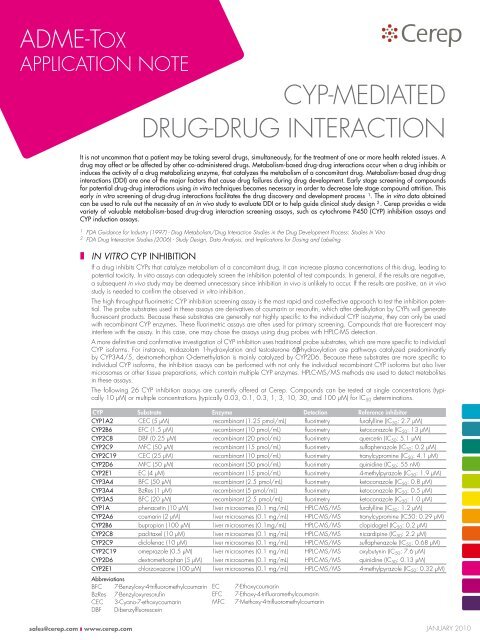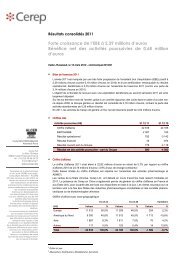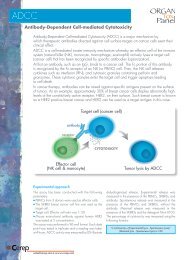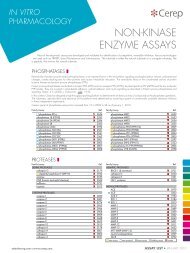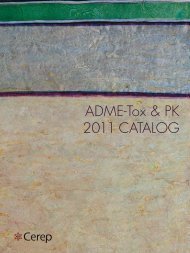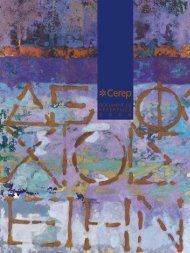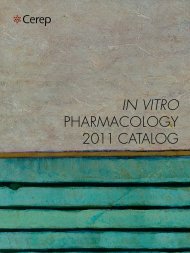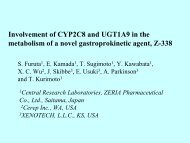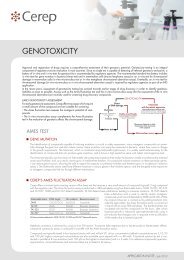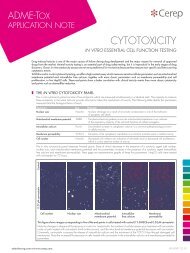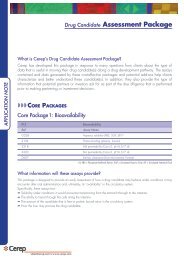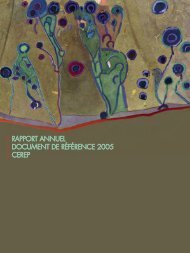cyp-mediaTed drug-drug inTeracTion - Cerep
cyp-mediaTed drug-drug inTeracTion - Cerep
cyp-mediaTed drug-drug inTeracTion - Cerep
Create successful ePaper yourself
Turn your PDF publications into a flip-book with our unique Google optimized e-Paper software.
adme-Tox<br />
application note<br />
CYP-mediated<br />
<strong>drug</strong>-<strong>drug</strong> interaction<br />
It is not uncommon that a patient may be taking several <strong>drug</strong>s, simultaneously, for the treatment of one or more health related issues. A<br />
<strong>drug</strong> may affect or be affected by other co-administered <strong>drug</strong>s. Metabolism-based <strong>drug</strong>-<strong>drug</strong> interactions occur when a <strong>drug</strong> inhibits or<br />
induces the activity of a <strong>drug</strong> metabolizing enzyme, that catalyzes the metabolism of a concomitant <strong>drug</strong>. Metabolism-based <strong>drug</strong>-<strong>drug</strong><br />
interactions (DDI) are one of the major factors that cause <strong>drug</strong> failures during <strong>drug</strong> development. Early stage screening of compounds<br />
for potential <strong>drug</strong>-<strong>drug</strong> interactions using in vitro techniques becomes necessary in order to decrease late stage compound attrition. This<br />
early in vitro screening of <strong>drug</strong>-<strong>drug</strong> interactions facilitates the <strong>drug</strong> discovery and development process 1 . The in vitro data obtained<br />
can be used to rule out the necessity of an in vivo study to evaluate DDI or to help guide clinical study design 2 . <strong>Cerep</strong> provides a wide<br />
variety of valuable metabolism-based <strong>drug</strong>-<strong>drug</strong> interaction screening assays, such as cytochrome P450 (CYP) inhibition assays and<br />
CYP induction assays.<br />
1 FDA Guidance for Industry (1997) - Drug Metabolism/Drug Interaction Studies in the Drug Development Process: Studies In Vitro<br />
2 FDA Drug Interaction Studies (2006) - Study Design, Data Analysis, and Implications for Dosing and Labeling<br />
❚ In vitro CYP inhibition<br />
If a <strong>drug</strong> inhibits CYPs that catalyze metabolism of a concomitant <strong>drug</strong>, it can increase plasma concentrations of this <strong>drug</strong>, leading to<br />
potential toxicity. In vitro assays can adequately screen the inhibition potential of test compounds. In general, if the results are negative,<br />
a subsequent in vivo study may be deemed unnecessary since inhibition in vivo is unlikely to occur. If the results are positive, an in vivo<br />
study is needed to confirm the observed in vitro inhibition.<br />
The high throughput fluorimetric CYP inhibition screening assay is the most rapid and cost-effective approach to test the inhibition potential.<br />
The probe substrates used in these assays are derivatives of coumarin or resorufin, which after dealkylation by CYPs will generate<br />
fluorescent products. Because these substrates are generally not highly specific to the individual CYP isozyme, they can only be used<br />
with recombinant CYP enzymes. These fluorimetric assays are often used for primary screening. Compounds that are fluorescent may<br />
interfere with the assay. In this case, one may chose the assays using <strong>drug</strong> probes with HPLC-MS detection.<br />
A more definitive and confirmative investigation of CYP inhibition uses traditional probe substrates, which are more specific to individual<br />
CYP isoforms. For instance, midazolam 1-hydroxylation and testosterone 6β-hydroxylation are pathways catalyzed predominantly<br />
by CYP3A4/5, dextromethorphan O-demethylation is mainly catalyzed by CYP2D6. Because these substrates are more specific to<br />
individual CYP isoforms, the inhibition assays can be performed with not only the individual recombinant CYP isoforms but also liver<br />
microsomes or other tissue preparations, which contain multiple CYP enzymes. HPLC-MS/MS methods are used to detect metabolites<br />
in these assays.<br />
The following 26 CYP inhibition assays are currently offered at <strong>Cerep</strong>. Compounds can be tested at single concentrations (typically<br />
10 µM) or multiple concentrations (typically 0.03, 0.1, 0.3, 1, 3, 10, 30, and 100 µM) for IC 50 determinations.<br />
CYP Substrate Enzyme Detection Reference inhibitor<br />
CYP1A2 CEC (5 µM) recombinant (1.25 pmol/mL) fluorimetry furafylline (IC 50 : 2.7 µM)<br />
CYP2B6 EFC (1.5 µM) recombinant (10 pmol/mL) fluorimetry ketoconazole (IC 50 : 13 µM)<br />
CYP2C8 DBF (0.25 µM) recombinant (20 pmol/mL) fluorimetry quercetin (IC 50 : 5.1 µM)<br />
CYP2C9 MFC (50 µM) recombinant (15 pmol/mL) fluorimetry sulfaphenazole (IC 50 : 0.2 µM)<br />
CYP2C19 CEC (25 µM) recombinant (10 pmol/mL) fluorimetry tranyl<strong>cyp</strong>romine (IC 50 : 4.1 µM)<br />
CYP2D6 MFC (50 µM) recombinant (50 pmol/mL) fluorimetry quinidine (IC 50 : 55 nM)<br />
CYP2E1 EC (4 µM) recombinant (15 pmol/mL) fluorimetry 4-methylpyrazole (IC 50 : 1.9 µM)<br />
CYP3A4 BFC (50 µM) recombinant (2.5 pmol/mL) fluorimetry ketoconazole (IC 50 : 0.8 µM)<br />
CYP3A4 BzRes (1 µM) recombinant (5 pmol/mL) fluorimetry ketoconazole (IC 50 : 0.5 µM)<br />
CYP3A5 BFC (20 µM) recombinant (2.5 pmol/mL) fluorimetry ketoconazole (IC 50 : 1.0 µM)<br />
CYP1A phenacetin (10 µM) liver microsomes (0.1 mg/mL) HPLC-MS/MS furafylline (IC 50 : 1.2 µM)<br />
CYP2A6 coumarin (2 µM) liver microsomes (0.1 mg/mL) HPLC-MS/MS tranyl<strong>cyp</strong>romine (IC50: 0.29 µM)<br />
CYP2B6 bupropion (100 µM) liver microsomes (0.1mg/mL) HPLC-MS/MS clopidogrel (IC 50 : 0.2 µM)<br />
CYP2C8 paclitaxel (10 µM) liver microsomes (0.1 mg/mL) HPLC-MS/MS nicardipine (IC 50 : 2.2 µM)<br />
CYP2C9 diclofenac (10 µM) liver microsomes (0.1 mg/mL) HPLC-MS/MS sulfaphenazole (IC 50 : 0.68 µM)<br />
CYP2C19 omeprazole (0.5 µM) liver microsomes (0.1 mg/mL) HPLC-MS/MS oxybutynin (IC 50 : 7.6 µM)<br />
CYP2D6 dextromethorphan (5 µM) liver microsomes (0.1 mg/mL) HPLC-MS/MS quinidine (IC 50 : 0.13 µM)<br />
CYP2E1 chlorzoxazone (100 µM) liver microsomes (0.1 mg/mL) HPLC-MS/MS 4-methylpyrazole (IC 50 : 0.32 µM)<br />
Abbreviations<br />
BFC 7-Benzyloxy-4-trifluoromethylcoumarin EC 7-Ethoxycoumarin<br />
BzRes 7-Benzyloxyresorufin<br />
EFC 7-Ethoxy-4-trifluoromethylcoumarin<br />
CEC 3-Cyano-7-ethoxycoumarin<br />
MFC 7-Methoxy-4-trifluoromethylcoumarin<br />
DBF Dibenzylfluorescein<br />
sales@cerep.com ❚ www.cerep.com January 2010
CYP-mediated <strong>drug</strong>-<strong>drug</strong> interaction Application note<br />
CYP Substrate Enzyme Detection Reference inhibitor<br />
CYP3A* midazolam (5 µM) liver microsomes (0.1 mg/mL) HPLC-MS/MS ketoconazole (IC 50 : 0.3 µM)<br />
CYP3A* testosterone (50 µM) liver microsomes (0.1 mg/mL) HPLC-MS/MS ketoconazole (IC 50 : 0.3 µM)<br />
CYP1A2 phenacetin (10 µM) recombinant (5 pmol/mL) HPLC-MS/MS furafylline (IC 50 : 0.8 µM)<br />
CYP2C9 diclofenac (10 µM) recombinant (40 pmol/mL) HPLC-MS/MS sulfaphenazole (IC 50 : 2.5 µM)<br />
CYP2C19 omeprazole (0.5 µM) recombinant (1 pmol/mL) HPLC-MS/MS tranyl<strong>cyp</strong>romine (IC 50 : 6.2 µM)<br />
CYP2D6 dextromethorphan (5 µM) recombinant (15 pmol/mL) HPLC-MS/MS quinidine (IC 50 : 65 nM)<br />
CYP3A4 * midazolam (5 µM) recombinant (20 pmol/mL) HPLC-MS/MS ketoconazole (IC 50 : 0.69 µM)<br />
CYP3A4 * testosterone (50 µM) recombinant (22 pmol/mL) HPLC-MS/MS ketoconazole (IC 50 : 0.9 µM)<br />
* FDA recommends the use of at least two structurally unrelated compounds as substrates for CYP3A4 inhibition screening.<br />
Using traditional CYP probe substrates, CYP inhibition can also be assessed using a cocktail approach, i.e. several probe substrates<br />
are added together and incubated simultaneously with a test compound. Either human liver microsomes or a mixture of human recombinant<br />
CYP isozymes can be used as the enzyme source. Because of the substrate specificity, each CYP isozyme metabolizes only its<br />
specific corresponding probe substrate. Substrates are chosen such that none of the substrates used in this assay should be an inhibitor<br />
of any other CYP isozyme. Therefore, CYP inhibition performed using a cocktail approach can generate results comparable to those<br />
produced from the single substrate assays described above. This cocktail approach allows one incubation to assess inhibitory effects of<br />
a compound on multiple CYPs, leading to higher throughput and greater cost-effectiveness. It is thus particularly well suited for screening<br />
a large number of compounds within a short period of time. <strong>Cerep</strong> offers 2 CYP cocktail inhibition assays, one with HLM and the other<br />
with a mixture of 5 human recombinant CYP isozymes (1A2, 2C9, 2C19, 2D6 and 3A4). In both assays a mixture of 5 CYP specific<br />
substrates are included, and the respective metabolites are detected by HPLC-MS/MS analysis. Five known CYP selective inhibitors are<br />
included in each assay as reference compounds and are tested individually at multiple concentrations for IC 50 determinations.<br />
Assay matrix Substrates (as a mixture) Protein/enzyme concentration Reference inhibitor (tested individually)<br />
HLM<br />
phenacetin (10 µM)<br />
diclofenac (10 µM)<br />
omeprazole (0.5 µM)<br />
dextromethorphan (5 µM)<br />
midazolam (5 µM)<br />
HLM(0.1 mg/mL)<br />
furafylline<br />
sulfaphenazole<br />
tranyl<strong>cyp</strong>romine<br />
quinidine<br />
ketoconazole<br />
Mixture of 5 rCYPs<br />
phenacetin (10 µM)<br />
diclofenac (10 µM)<br />
omeprazole (0.5 µM)<br />
dextromethorphan (5 µM)<br />
midazolam (5 µM)<br />
rCYP1A2 (1 pmol/mL)<br />
rCYP2C9 (1 pmol/mL)<br />
rCYP2C19 (1 pmol/mL)<br />
rCYP2D6 (1 pmol/mL)<br />
rCYP3A4 (1 pmol/mL)<br />
furafylline<br />
sulfaphenazole<br />
tranyl<strong>cyp</strong>romine<br />
quinidine<br />
ketoconazole<br />
The current average IC 50 values of the 5 reference compounds from the two cocktail CYP inhibition assays are presented below.<br />
Reference Inhibitors<br />
Isozyme inhibited furafylline sulfaphenazole tranyl<strong>cyp</strong>romine quinidine ketoconazole<br />
Assay matrix: pooled human liver microsomes<br />
CYP 1A 4.9 >500 24 >500 26<br />
CYP2C9 >500 0.59 31 >500 12<br />
CYP2C19 >500 >500 10 2.6 6<br />
CYP2D6 >500 >500 29 0.07 27<br />
CYP3A >500 >500 240 59 0.07<br />
Assay matrix: mixture of 5 human recombinant CYPs<br />
CYP1A2 0.9 >500 47 >500 134<br />
CYP2C9 >500 1.1 75 >500 25<br />
CYP2C19 254 >500 7.7 45 6.7<br />
CYP2D6 >500 >500 42 0.02 49<br />
CYP3A4 >500 136 398 68 0.15<br />
❚ Time-dependent CYP inhibition<br />
Time-dependent inhibition is also referred to as mechanism-based inhibition, which usually results from irreversible or quasi-irreversible<br />
binding of a test compound or its metabolite to the active site of a CYP enzyme during the biotransformation process. Thus, with each<br />
metabolite generated a certain portion of enzyme is inactivated. The percent inhibition increases with incubation time. Based on this<br />
mechanism, time-dependent inhibition can be identified by two sets of simultaneous experiments: one is to pre-incubate enzyme (typically<br />
for 30 min) with a test compound in the presence of the cofactor NADPH, which generates metabolites, while the other is to pre-incubate<br />
enzyme with the test compound in the absence of NADPH, which does not generate metabolites. The residual CYP enzyme activity is<br />
then analyzed by incubation of diluted pre-incubation mixture (generally 1 to 10 dilution) with a probe substrate. If the test compound<br />
is a time-dependent inhibitor, it should exhibit a higher percent inhibition (or lower IC 50 value) after a pre-incubation in the presence<br />
of NADPH. Conversely, if the test compound does not demonstrate an increase in inhibition after a pre-incubation in the presence of<br />
NADPH, the compound is not considered a time-dependent inhibitor. Apparently, the inhibitory potency of a time-dependent inhibitor<br />
would be underestimated in direct CYP inhibition assays (without pre-incubation of the inhibitor with the enzyme).<br />
2
CYP-mediated <strong>drug</strong>-<strong>drug</strong> interaction Application note<br />
Both recombinant enzyme and liver microsomes can be used in time-dependent inhibition assays, however, the latter is recommended<br />
because the metabolite that inactivates a CYP isozyme can also be generated by other CYP isozymes present in liver microsomes. For<br />
this reason, a false negative result could be generated from the assay using individual recombinant CYPs.<br />
Currently 5 time-dependent CYP inhibition assays are offered at <strong>Cerep</strong>. Pooled human liver microsomal preparation (1 mg/mL in preincubation<br />
and 0.1 mg/mL in final incubation with substrate) is used as the enzyme source and the respective metabolites are detected<br />
by HPLC-MS/MS methods.<br />
CYP Substrate Time-dependent inhibitor Non time-dependent inhibitor<br />
CYP1A phenacetin (50 µm) furafylline<br />
IC 50 = 0.95 µM for +NADPH<br />
IC 50 > 10 µM for -NADPH<br />
CYP2C9 diclofenac (50 µm) tienilic acid<br />
IC 50 = 0.59 µM for +NADPH<br />
IC 50 > 10 µM for -NADPH<br />
CYP2C19 omeprazole (10 µm) ticlopidine<br />
IC 50 = 163 µM for +NADPH<br />
IC 50 > 1000 µM for -NADPH<br />
CYP2D6 dextromethorphan (25 µm) methylenedioxymethamphetamine (MDMA)<br />
IC 50 = 0.67 µM for +NADPH<br />
IC 50 not calculable µM for -NADPH<br />
CYP3A midazolam (25 µm) troleandomycin<br />
IC 50 = 1.6 µM for +NADPH<br />
IC 50 not calculable for -NADPH<br />
fluvoxamine<br />
IC 50 = 0.19 µM for +NADPH<br />
IC 50 = 0.41 µM for -NADPH<br />
sulfaphenazole<br />
IC 50 = 9.1 µM for +NADPH<br />
IC 50 = 11 µM for -NADPH<br />
oxybutynin<br />
IC 50 = 173 µM for +NADPH<br />
IC 50 = 185 µM for -NADPH<br />
quinidine<br />
IC 50 = 2.0 µM for +NADPH<br />
IC 50 = 2.7 µM for -NADPH<br />
ketoconazole<br />
IC 50 = 2.8 µM for +NADPH<br />
IC 50 = 2.0 µM for -NADPH<br />
❚ CYP induction<br />
Some chemicals can induce the activity of CYP enzymes. These inducers will increase the metabolism of the co-administered <strong>drug</strong>s that<br />
are substrates of the induced CYP enzymes, resulting in these <strong>drug</strong>s losing efficacy. CYP enzymes such as CYP1A2, CYP2B6, CYP2C8,<br />
CYP2C9, CYP2C19 and CYP3A4 are susceptible to induction. While cellular CYP1A and CYP2B6 inductions are mediated by Aryl<br />
hydrocarbon receptor (AhR) and constitutive androstane receptor (CAR), respectively, CYP2C8, CYP2C9, CYP2C19, and CYP3A4<br />
are induced through pregnane X receptor (PXR). Based on the identified cellular mechanism, if a compound is not a CYP3A inducer, it<br />
will not induce these CYP2C isoforms. <strong>Cerep</strong>’s in vitro CYP induction assays allow identification of compounds that may induce CYP<br />
activities, causing potential <strong>drug</strong>-<strong>drug</strong> interactions.<br />
CYP Substrate Detected metabolite Positive control<br />
CYP1A ethoxyresorufin (2 µM) resorufin omeprazole (50 µM)<br />
CYP2B6 bupropion (200 µM) hydrxybupropion phenobarbital (1 mM)<br />
CYP3A midazolam (10 µM) 1-hydroxymidazolam rifampin (10 µM)<br />
CYP1A ethoxyresorufin (2 µM) resorufin β-naphthoflavone (10 µM)<br />
CYP3A midazolam (10 µM) 1-hydroxymidazolam dexamethasone (50 µM)<br />
<strong>Cerep</strong>’s induction assays are performed using plateable cryopreserved human (male or female, single donors) or rat (female, Sprague-<br />
Dawley, pool of 10 or more) hepatocytes (0.7 million cells/mL). The hepatocytes are first plated and incubated with cell culture medium for<br />
2 days to allow recovery from processing procedures and adapt them to the culture environment. The hepatocytes are then exposed to the<br />
test compound at 3 concentrations that span the therapeutic range, including one concentration that is 10 times greater than the average<br />
expected plasma <strong>drug</strong> concentration (our default concentrations are 1, 10 and 100 µM in case the therapeutic range is unknown), in<br />
triplicate, for 2 days. At the end of the 2-day exposure, the CYP activity is determined using the respective substrate. The corresponding<br />
metabolite is detected by HPLC-MS/MS methods. The negative control (solvent only) and positive controls are included in each assay. Per<br />
FDA guidance (2006), a CYP induction<br />
study should be conducted using human CYP induction (human hepatocytes)<br />
hepatocytes from 3 individual donors.<br />
<br />
<br />
<br />
<br />
<br />
<br />
<br />
The result is expressed as % of the positive<br />
<br />
<br />
<br />
<br />
<br />
<br />
<br />
<br />
control (by comparing net activity changes<br />
<br />
<br />
<br />
between test compound treated cells<br />
<br />
<br />
and positive control treated cells). A test<br />
<br />
<br />
<br />
compound is considered as an in vitro<br />
<br />
<br />
CYP inducer if it produces a change that<br />
<br />
<br />
is equal to or greater than 40% of the<br />
<br />
<br />
<br />
positive control, and a subsequent in vivo<br />
evaluation is warranted.<br />
CYP1A CYP2B6 CYP3A<br />
❚ Quality control<br />
<br />
<br />
<br />
<br />
In each assay, the respective reference compound is tested concurrently with the test compound in order to assess the assay suitability.<br />
The data are compared with historical values determined at <strong>Cerep</strong>. The assay is rendered valid if the suitability criteria are met, in<br />
accordance with the corresponding Standard Operating Procedure.<br />
<br />
<br />
<br />
<br />
<br />
<br />
<br />
<br />
<br />
<br />
<br />
<br />
3
© <strong>Cerep</strong> - January 2010<br />
❚ questions or concerns ?<br />
Please contact us: sales@cerep.com<br />
FRANCE<br />
Le Bois l’Evêque<br />
86600 CELLE L’EVESCAULT<br />
tel. +33 (0)5 49 89 30 00<br />
(Headquarters)<br />
155 boulevard Haussmann<br />
75008 PARIS<br />
tel. +33 (0)1 45 64 44 60<br />
USA<br />
15318 N.E. 95th Street<br />
Redmond, WA 98052<br />
tel. +1 (425) 895 8666<br />
japan<br />
Namiki Shoji Co., Ltd.<br />
Kenseishinjuku Bldg. 5-5-3<br />
Shinjuku, Shinjuku-ku<br />
TOKYO, 160-0022<br />
tel. +81 (0)3 3354 4026<br />
fax +81 (0)3 3352 2196<br />
CHINA<br />
Ai Di Sheng (Edison) Road 326,<br />
302-1 room<br />
Zhangjiang Hich-Tech Park<br />
Shanghai<br />
tel. +86 18702160370<br />
sales@cerep.com<br />
www.cerep.com


